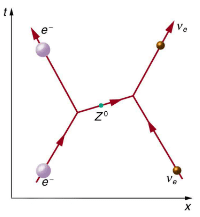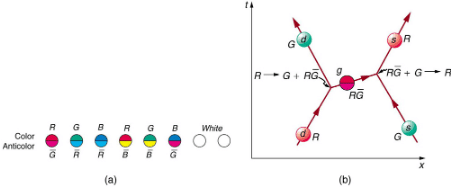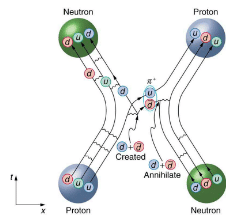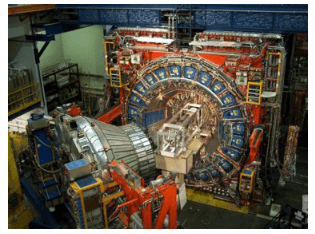GUTs: The Unification of Forces | Modern Physics for IIT JAM PDF Download
Present quests to show that the four basic forces are different manifestations of a single unified force follow a long tradition. In the 19th century, the distinct electric and magnetic forces were shown to be intimately connected and are now collectively called the electromagnetic force. More recently, the weak nuclear force has been shown to be connected to the electromagnetic force in a manner suggesting that a theory may be constructed in which all four forces are unified. Certainly, there are similarities in how forces are transmitted by the exchange of carrier particles, and the carrier particles themselves (the gauge bosons) are also similar in important ways. The analogy to the unification of electric and magnetic forces is quite good—the four forces are distinct under normal circumstances, but there are hints of connections even on the atomic scale, and there may be conditions under which the forces are intimately related and even indistinguishable. The search for a correct theory linking the forces, called the Grand Unified Theory (GUT), is explored in this section in the realm of particle physics. Frontiers of Physics expands the story in making a connection with cosmology, on the opposite end of the distance scale.
Feynman diagram showing how the weak nuclear force is transmitted by the carrier particle  , similar to the diagrams for the electromagnetic and strong nuclear forces. In the 1960s, a gauge theory, called electroweak theory, was developed by Steven Weinberg, Sheldon Glashow, and Abdus Salam and proposed that the electromagnetic and weak forces are identical at sufficiently high energies. One of its predictions, in addition to describing both electromagnetic and weak force phenomena, was the existence of the
, similar to the diagrams for the electromagnetic and strong nuclear forces. In the 1960s, a gauge theory, called electroweak theory, was developed by Steven Weinberg, Sheldon Glashow, and Abdus Salam and proposed that the electromagnetic and weak forces are identical at sufficiently high energies. One of its predictions, in addition to describing both electromagnetic and weak force phenomena, was the existence of the  , and Zo carrier particles. Not only were three particles having spin 1 predicted, the mass of the W+ and W- was predicted to be
, and Zo carrier particles. Not only were three particles having spin 1 predicted, the mass of the W+ and W- was predicted to be  and that of the
and that of the  was predicted to be
was predicted to be  . (Their masses had to be about 1000 times that of the pion, or about
. (Their masses had to be about 1000 times that of the pion, or about  , since the range of the weak force is about 1000 times less than the strong force carried by virtual pions.) In 1983, these carrier particles were observed at CERN with the predicted characteristics, including masses having the predicted values as seen . This was another triumph of particle theory and experimental effort, resulting in the 1984 Nobel Prize to the experiment’s group leaders Carlo Rubbia and Simon van der Meer. Theorists Weinberg, Glashow, and Salam had already been honored with the 1979 Nobel Prize for other aspects of electroweak theory.
, since the range of the weak force is about 1000 times less than the strong force carried by virtual pions.) In 1983, these carrier particles were observed at CERN with the predicted characteristics, including masses having the predicted values as seen . This was another triumph of particle theory and experimental effort, resulting in the 1984 Nobel Prize to the experiment’s group leaders Carlo Rubbia and Simon van der Meer. Theorists Weinberg, Glashow, and Salam had already been honored with the 1979 Nobel Prize for other aspects of electroweak theory.

Although the weak nuclear force is very short ranged ( , as indicated), its effects on atomic levels can be measured given the extreme precision of modern techniques. Since electrons spend some time in the nucleus, their energies are affected, and spectra can even indicate new aspects of the weak force, such as the possibility of other carrier particles. So systems many orders of magnitude larger than the range of the weak force supply evidence of electroweak unification in addition to evidence found at the particle scale.
, as indicated), its effects on atomic levels can be measured given the extreme precision of modern techniques. Since electrons spend some time in the nucleus, their energies are affected, and spectra can even indicate new aspects of the weak force, such as the possibility of other carrier particles. So systems many orders of magnitude larger than the range of the weak force supply evidence of electroweak unification in addition to evidence found at the particle scale.
Gluons ( ) are the proposed carrier particles for the strong nuclear force, although they are not directly observed. Like quarks, gluons may be confined to systems having a total color of white. Less is known about gluons than the fact that they are the carriers of the weak and certainly of the electromagnetic force. QCD theory calls for eight gluons, all massless and all spin 1. Six of the gluons carry a color and an anticolor, while two do not carry color, as illustrated:
) are the proposed carrier particles for the strong nuclear force, although they are not directly observed. Like quarks, gluons may be confined to systems having a total color of white. Less is known about gluons than the fact that they are the carriers of the weak and certainly of the electromagnetic force. QCD theory calls for eight gluons, all massless and all spin 1. Six of the gluons carry a color and an anticolor, while two do not carry color, as illustrated:
(a). There is indirect evidence of the existence of gluons in nucleons. When high-energy electrons are scattered from nucleons and evidence of quarks is seen, the momenta of the quarks are smaller than they would be if there were no gluons. That means that the gluons carrying force between quarks also carry some momentum, inferred by the already indirect quark momentum measurements. At any rate, the gluons carry color charge and can change the colors of quarks when exchanged, as seen
(b). In the figure, a red down quark interacts with a green strange quark by sending it a gluon. That gluon carries red away from the down quark and leaves it green, because it is an  (red-antigreen) gluon. (Taking antigreen away leaves you green.) Its antigreenness kills the green in the strange quark, and its redness turns the quark red.
(red-antigreen) gluon. (Taking antigreen away leaves you green.) Its antigreenness kills the green in the strange quark, and its redness turns the quark red.
In figure
(a), the eight types of gluons that carry the strong nuclear force are divided into a group of six that carry color and a group of two that do not. Figure
(b) shows that the exchange of gluons between quarks carries the strong force and may change the color of a quark.

The strong force is complicated, since observable particles that feel the strong force (hadrons) contain multiple quarks. The quark and gluon details of pion exchange between a proton and a neutron as illustrated earlier. The quarks within the proton and neutron move along together exchanging gluons, until the proton and neutron get close together. As the  quark leaves the proton, a gluon creates a pair of virtual particles, a
quark leaves the proton, a gluon creates a pair of virtual particles, a  quark and a antiquark. The
quark and a antiquark. The  quark stays behind and the proton turns into a neutron, while the
quark stays behind and the proton turns into a neutron, while the  and
and  move together as a
move together as a  ( confirms the composition for the
( confirms the composition for the  .) The
.) The  annihilates a
annihilates a  quark in the neutron, the
quark in the neutron, the  joins the neutron, and the neutron becomes a proton. A pion is exchanged and a force is transmitted.
joins the neutron, and the neutron becomes a proton. A pion is exchanged and a force is transmitted.
This Feynman diagram is the same interaction as shown , but it shows the quark and gluon details of the strong force interaction.

It is beyond the scope of this text to go into more detail on the types of quark and gluon interactions that underlie the observable particles, but the theory (quantum chromodynamicsor QCD) is very self-consistent. So successful have QCD and the electroweak theory been that, taken together, they are called the Standard Model. Advances in knowledge are expected to modify, but not overthrow, the Standard Model of particle physics and forces.
Making Connections: Unification of Forces
Grand Unified Theory (GUT) is successful in describing the four forces as distinct under normal circumstances, but connected in fundamental ways. Experiments have verified that the weak and electromagnetic force become identical at very small distances and provide the GUT description of the carrier particles for the forces. GUT predicts that the other forces become identical under conditions so extreme that they cannot be tested in the laboratory, although there may be lingering evidence of them in the evolution of the universe. GUT is also successful in describing a system of carrier particles for all four forces, but there is much to be done, particularly in the realm of gravity.
How can forces be unified? They are definitely distinct under most circumstances, for example, being carried by different particles and having greatly different strengths. But experiments show that at extremely small distances, the strengths of the forces begin to become more similar. In fact, electro weak theory’s prediction of the W+, W-, and  carrier particles was based on the strengths of the two forces being identical at extremely small distances . As discussed in case of the creation of virtual particles for extremely short times, the small distances or short ranges correspond to the large masses of the carrier particles and the correspondingly large energies needed to create them. Thus, the energy scale on the horizontal axis corresponds to smaller and smaller distances, with 100 GeV corresponding to approximately, 10-18m for example. At that distance, the strengths of the EM and weak forces are the same. To test physics at that distance, energies of about 100 GeV must be put into the system, and that is sufficient to create and release the
carrier particles was based on the strengths of the two forces being identical at extremely small distances . As discussed in case of the creation of virtual particles for extremely short times, the small distances or short ranges correspond to the large masses of the carrier particles and the correspondingly large energies needed to create them. Thus, the energy scale on the horizontal axis corresponds to smaller and smaller distances, with 100 GeV corresponding to approximately, 10-18m for example. At that distance, the strengths of the EM and weak forces are the same. To test physics at that distance, energies of about 100 GeV must be put into the system, and that is sufficient to create and release the  ,
,  , and Z0 carrier particles. At those and higher energies, the masses of the carrier particles becomes less and less relevant, and the Zo in particular resembles the massless, chargeless, spin 1 photon. In fact, there is enough energy when things are pushed to even smaller distances to transform the, and Z0 into massless carrier particles more similar to photons and gluons. These have not been observed experimentally, but there is a prediction of an associated particle called the Higgs boson. The mass of this particle is not predicted with nearly the certainty with which the mass of the
, and Z0 carrier particles. At those and higher energies, the masses of the carrier particles becomes less and less relevant, and the Zo in particular resembles the massless, chargeless, spin 1 photon. In fact, there is enough energy when things are pushed to even smaller distances to transform the, and Z0 into massless carrier particles more similar to photons and gluons. These have not been observed experimentally, but there is a prediction of an associated particle called the Higgs boson. The mass of this particle is not predicted with nearly the certainty with which the mass of the  and
and  particles were predicted, but it was hoped that the Higgs boson could be observed at the now-canceled Superconducting Super Collider (SSC). Ongoing experiments at the Large Hadron Collider at CERN have presented some evidence for a Higgs boson with a mass of 125 GeV, and there is a possibility of a direct discovery during 2012. The existence of this more massive particle would give validity to the theory that the carrier particles are identical under certain circumstances.
particles were predicted, but it was hoped that the Higgs boson could be observed at the now-canceled Superconducting Super Collider (SSC). Ongoing experiments at the Large Hadron Collider at CERN have presented some evidence for a Higgs boson with a mass of 125 GeV, and there is a possibility of a direct discovery during 2012. The existence of this more massive particle would give validity to the theory that the carrier particles are identical under certain circumstances.
The relative strengths of the four basic forces vary with distance and, hence, energy is needed to probe small distances. At ordinary energies (a few eV or less), the forces differ greatly as indicated. However, at energies available at accelerators, the weak and EM forces become identical, or unified. Unfortunately, the energies at which the strong and electroweak forces become the same are unreachable even in principle at any conceivable accelerator. The universe may provide a laboratory, and nature may show effects at ordinary energies that give us clues about the validity of this graph.

The small distances and high energies at which the electroweak force becomes identical with the strong nuclear force are not reachable with any conceivable human-built accelerator. At energies of about  (16,000 J per particle), distances of about
(16,000 J per particle), distances of about  can be probed. Such energies are needed to test theory directly, but these are about
can be probed. Such energies are needed to test theory directly, but these are about  higher than the proposed giant SSC would have had, and the distances are about
higher than the proposed giant SSC would have had, and the distances are about smaller than any structure we have direct knowledge of. This would be the realm of various GUTs, of which there are many since there is no constraining evidence at these energies and distances. Past experience has shown that any time you probe so many orders of magnitude further (here, about
smaller than any structure we have direct knowledge of. This would be the realm of various GUTs, of which there are many since there is no constraining evidence at these energies and distances. Past experience has shown that any time you probe so many orders of magnitude further (here, about ), you find the unexpected. Even more extreme are the energies and distances at which gravity is thought to unify with the other forces in a TOE. Most speculative and least constrained by experiment are TOEs, one of which is called Superstring theory. Superstrings are entities that are
), you find the unexpected. Even more extreme are the energies and distances at which gravity is thought to unify with the other forces in a TOE. Most speculative and least constrained by experiment are TOEs, one of which is called Superstring theory. Superstrings are entities that are  in scale and act like one-dimensional oscillating strings and are also proposed to underlie all particles, forces, and space itself.
in scale and act like one-dimensional oscillating strings and are also proposed to underlie all particles, forces, and space itself.

which violates both conservation of baryon number and electron family number. Although
 is an extremely long time (about
is an extremely long time (about times the age of the universe), there are a lot of protons, and detectors have been constructed to look for the proposed decay mode. It is somewhat comforting that proton decay has not been detected, and its experimental lifetime is now greater than
times the age of the universe), there are a lot of protons, and detectors have been constructed to look for the proposed decay mode. It is somewhat comforting that proton decay has not been detected, and its experimental lifetime is now greater than  . This does not prove GUTs wrong, but it does place greater constraints on the theories, benefiting theorists in many ways.From looking increasingly inward at smaller details for direct evidence of electroweak theory and GUTs, we turn around and look to the universe for evidence of the unification of forces. In the 1920s, the expansion of the universe was discovered. Thinking backward in time, the universe must once have been very small, dense, and extremely hot. At a tiny fraction of a second after the fabled Big Bang, forces would have been unified and may have left their fingerprint on the existing universe. This, one of the most exciting forefronts of physics, is the subject of Frontiers of Physics.
. This does not prove GUTs wrong, but it does place greater constraints on the theories, benefiting theorists in many ways.From looking increasingly inward at smaller details for direct evidence of electroweak theory and GUTs, we turn around and look to the universe for evidence of the unification of forces. In the 1920s, the expansion of the universe was discovered. Thinking backward in time, the universe must once have been very small, dense, and extremely hot. At a tiny fraction of a second after the fabled Big Bang, forces would have been unified and may have left their fingerprint on the existing universe. This, one of the most exciting forefronts of physics, is the subject of Frontiers of Physics.In the Tevatron accelerator at Fermilab, protons and antiprotons collide at high energies, and some of those collisions could result in the production of a Higgs boson in association with a W boson. When the W boson decays to a high-energy lepton and a neutrino, the detector triggers on the lepton, whether it is an electron or a muon.

1. Attempts to show unification of the four forces are called Grand Unified Theories (GUTs) and have been partially successful, with connections proven between EM and weak forces in electroweak theory.
2. The strong force is carried by eight proposed particles called gluons, which are intimately connected to a quantum number called color—their governing theory is thus called quantum chromodynamics (QCD). Taken together, QCD and the electroweak theory are widely accepted as the Standard Model of particle physics.
3. Unification of the strong force is expected at such high energies that it cannot be directly tested, but it may have observable consequences in the as-yet unobserved decay of the proton and topics to be discussed in the next chapter. Although unification of forces is generally anticipated, much remains to be done to prove its validity.
|
52 videos|44 docs|15 tests
|
FAQs on GUTs: The Unification of Forces - Modern Physics for IIT JAM
| 1. What is the meaning of GUTs in physics? |  |
| 2. How do Grand Unified Theories (GUTs) aim to unify the forces of nature? |  |
| 3. What are the implications of successfully unifying the forces of nature through GUTs? |  |
| 4. Are there any experimental evidences supporting the existence of GUTs? |  |
| 5. Can GUTs be tested experimentally? |  |





















